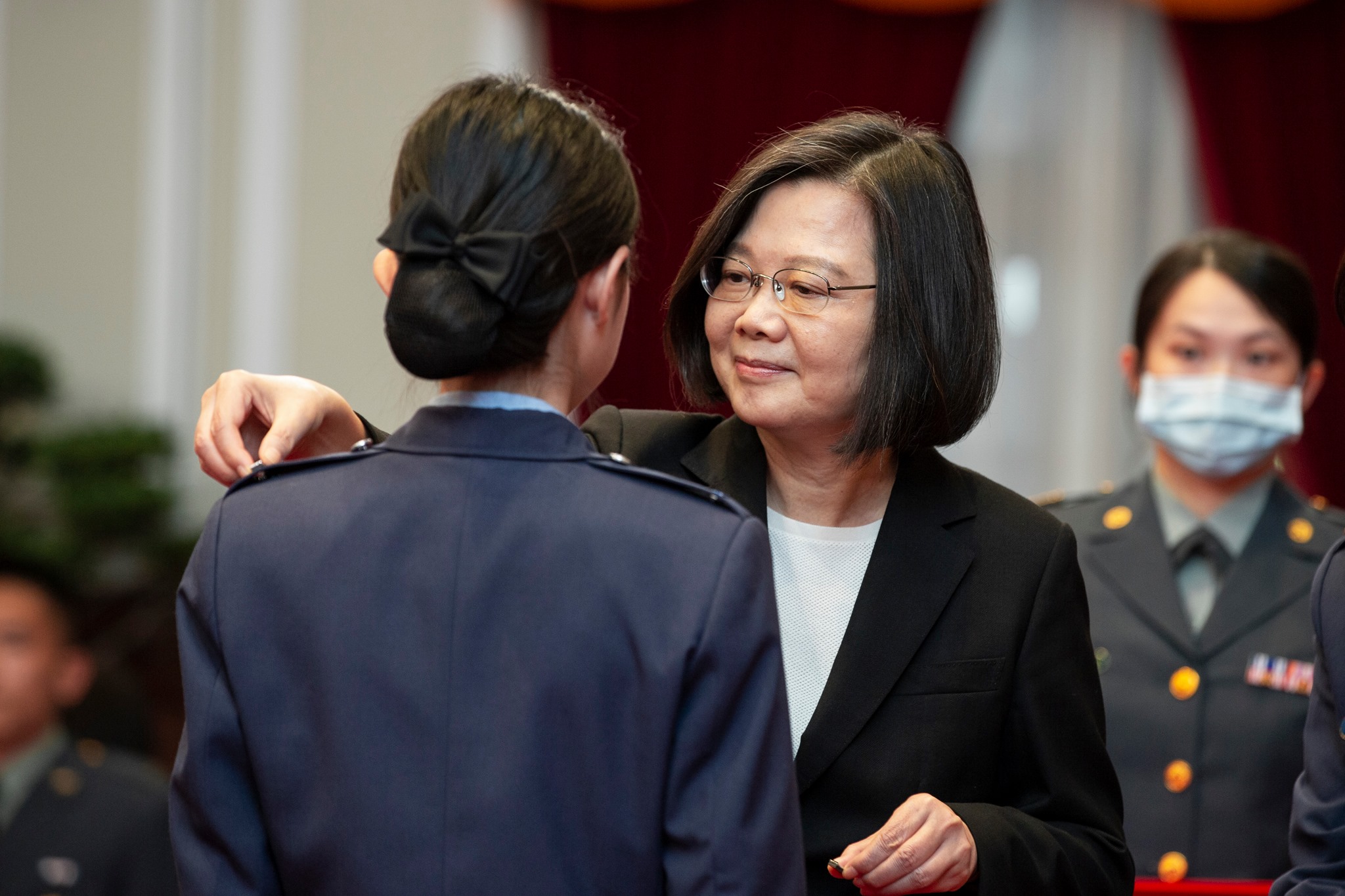The greatest impediment to ‘peaceful’ unification in the Taiwan Strait is the consolidation of a distinct system of beliefs and values in Taiwan, irrespective of political affiliation. Pro-unification groups want to break that bond and thereby weaken Taiwan’s ability to resist.
Every year around “2.28” — the day on which the massacre of thousands of Taiwanese by Kuomintang (KMT) forces in 1947 is commemorated — the raw emotions on both sides of the historical divide come to a boil, resulting in excess of rhetoric and the occasional incident. The more passionate voices on either end of the political spectrum have used this period of remembrance to highlight a longstanding animosity between the “green” and “blue” camps.
On the “green” side, while most rightly bemoan the lack of progress made over the years in opening the archives of the White Terror and ensuring accountability, more radical voices have also used the occasion to lambaste the KMT and target symbols of the Chiang Kai-shek regime by spray painting, and sometimes attempting to topple, statues of the former leader.
Radicals in the “blue” camp, meanwhile, have used that period to downplay the magnitude and significance of 2.28 and the ensuing White Terror, sometimes presenting “evidence” that could only result in aggravating the pain of the victims and their descendants. A number of KMT politicians have also portrayed efforts by the government and civil society to shed light on past traumas as a poorly veiled retributive attempt to annihilate the KMT and deprive it of its assets.
The ‘ethnic’ card
Common to the rhetorical excesses of both sides is the focus on the supposedly “ethnic” characteristics of the conflict, one pitting native Taiwanese against exogenous “Han” Chinese. This has resulted in a tendency to blame all waishengren (“mainlanders”) and their descendants for the KMT’s “original sin,” as if the politics of the time were somehow passed down generations. Beyond the painful memories associated with 2.28, this view of the “other” has often poisoned relationships in the workplace — particularly in government, what with the heavy criticism levelled at President Tsai Ing-wen by the deeper greens for her “mainlander”-heavy Cabinet, for example.
Although the blue camp admittedly still has its share of dinosaurs who hold the Taiwanese in contempt and will have nothing to do with accountability, the “ethnic” card is still used far too often by a segment of the green camp to sideline competitors in government (“he or she is a son or daughter of a mainlander and former KMT official and therefore can do no good”) or to cover for incompetence in their midst (“he or she is the son or daughter of a ‘green’ doctor from the south and therefore should get a free pass”).
This longstanding chasm continues to divide Taiwanese society and fails to take into account the gradual, but undeniable, indigenization of subsequent generations of waishengren since 1947, most of whom now regard themselves as Taiwanese and Taiwan as their home. This process is reflected in opinion polls since the 1990s showing a steady rise in self-identification as Taiwanese and dropping support for unification with China, a trend that is expected to continue and that even accelerated during periods of closer contact with China (2008-2016). The composition of the Sunflower Movement and other civic groups that have challenged the government in recent years also highlighted the increasingly “multiethnic” nature of Taiwan’s youth and distancing from earlier modes of self-identification deriving primarily from one’s “ethnicity.” Over the decades, self-identification and nationalism have taken on a civic form, fuelled not by one’s DNA but rather by the liberal-democratic norms and values that now symbolize Taiwan.
This consolidation of an idiosyncratic identity is probably the greatest impediment to Beijing’s efforts to “peacefully” unify Taiwan, as its “natural” allies in the blue camp increasingly identify with Taiwan rather than China, the land of their ancestors. Even those in the blue camp who have retained some emotional attachment to the Republic of China (ROC) have nevertheless embraced the values, freedoms and mores that define Taiwan today and which contrast with the People’s Republic of China (PRC), thus contributing to the drop in support for unification with China. The more such views are consolidated, the stronger will Taiwan’s resistance be to efforts by China to annex it, by means military or otherwise.
Unity above all
A united front against China (or as united a front as possible, knowing that differences are inherent to politics) is therefore in Taiwan’s favor, and disunity its greatest enemy.
Which is why, following the transformational events in the spring of 2014 and the subsequent victory of the Taiwan-centric Democratic Progressive Party (DPP) in the January 2016 elections, the Chinese Communist Party (CCP) and its proxies in Taiwan have intensified their efforts to fuel divisions within Taiwanese society in hopes of sparking a new round of escalating conflict. Their goal is nothing less than to turn back the clock and return Taiwan to an era of “ethnic” division.
As a result, and as we saw earlier this week at events surrounding 2.28, pro-CCP groups, the so-called “Blue Sky Alliance,” as well as opportunistic allies in the deep-blue camp resorted to intimidation, and in some cases violence, to spark unrest.
On Feb. 27, the launch of a new book on the 228 Massacre by historian Chen Yi-shen was disrupted by individuals associated with the deep blue camp and nearly descended into violence. The next day, on 2.28, deep-blue representatives and members of the pro-unification Concentric Patriot Association of the ROC clashed with green green-camp activists at Liberty Square in Taipei. During a commemorative concert at the same location, participants were reportedly shot at with BB guns, one of the victims observing that 70 years prior, real bullets had been used against members of society.
Members of the Concentric Patriot Association of the ROC have long been known for physically assaulting their enemies, whether they be Falun Gong practitioners outside Taipei 101, former president Chen Shui-bian, or Sunflower activists. Along with their allies in the China Unification Promotion Party and triads such as the Bamboo Union and the Four Seas Gang, this cohort of pro-CCP “activists” has become increasingly active in recent years, particularly since the DPP’s electoral successes in 2016, and is expected to continue doing so (see also Convergence or Conflict in the Taiwan Strait, chapters 5, 6 and 13).

Chinese tourists are greeted by the pro-unification Concentric Patriot Association of the ROC outside Taipei 101 on March 15, 2014 (Photo: J. Michael Cole).
This pro-CCP “civil society,” along with the less ideological fellow travelers who have joined them at some events, remains marginal and unrepresentative of the wider blue camp that, though politically opposed to the DPP, has little in common with Beijing’s aspirations. However, actions by the deep-green camp, from the toppling of CKS statues to continued discrimination against waishengren, inadvertently legitimize the “red” camp in Taiwanese politics by creating a false moral equivalence over extremist action. If a deep-green civil society can use illegal means to target symbols associated with their ideological opponents, then why shouldn’t the deep-blues (or even “reds”) do so as well? (Repugnant though CKS and other symbols may be to members of the green camp, their removal should be the remit of elected authorities and be enacted by legal means.)
Another dangerous aspect to these activities is the risk of engendering a vicious circle, with the actions of one side prompting retaliation by the other. Such behavior will inevitably cause collateral damage and thereby enlarge the pool of victims and participants, especially if both sides resume vilification along “ethnic” lines.
The green camp mustn’t fall into that trap, as spiralling violence and resulting divisions can only help China. Instead, members of the green camp should hold their instincts to fight back in check, even when they are physically assaulted or shot at with BB guns. Yes, they could win those fights, but that would constitute a pyrrhic victory: by retaliating they would only sow their own demise. Thus, when they are the target of violence, they should lobby their city councilors and legislators, and pressure law enforcement and intelligence agencies, to investigate — especially when the instigators conceivably have ties to and may be financed by the CCP and/or are affiliated with organized crime.
Society must continue to occupy the moral high ground by reaching out across the political spectrum and focussing on the many overlapping interests of both the green and blue camps rather than highlight their differences. This process has to occur from the top down and the bottom up, and therefore is the responsibility of both the government and civil society. Only then will truth and reconciliation efforts appear less like an exercise in retribution by green victors and more a legitimate attempt to shed light on past traumas to learn from history and to ensure a better future for all. Taiwanese should never forget who their real enemy is and must therefore do everything in their power to avoid disunity.
The people of Taiwan have already won the battle of identity by developing an identity that is distinctly theirs, regardless of their ancestry or party affiliation; only marginals continue to subscribe to the idea that Taiwan’s future lies with China. The worse they could do would be to destroy the fruits of that victory by reopening old wounds and forgetting the myriad things that are cherished by the great majority of people here. KMT or DPP, blue or green, the divisions can be transcended and are generally more tactical than fundamental; the real chasm is between Taiwan and China.
And disunity in Taiwan is the bridge that Beijing hopes to build between the two sides.
You might also like
More from Cross-Strait
Beijing Was Cooking the Frog in Hong Kong Well Before the National Security Law
Well before the coming into force of the NSL on July 1, the special administrative region had already become a …
President Tsai’s Second Term and Cross-Strait Relations: What to Watch Out For
The next four years will be marked by uncertainty over China’s trajectory and the state of the world in the …
As Coronavirus Crisis Intensifies, Beijing Continues to Play Politics Over Taiwan
With a major epidemic on its hands, the Chinese government has not ceased its political warfare activities against Taiwan. It …









